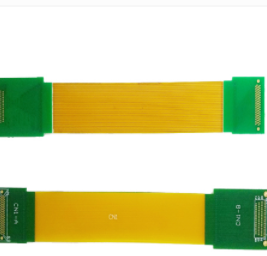Three kinds of operation methods in the production process of soft and hard board
The copper wire of the rigid-flex board is broken (also commonly referred to as copper rejection). Rigid-flex board manufacturers all say that it is the problem of laminates and require their rigid-flex board production plants to bear the bad losses.
1. Process factors of the soft and hard board factory:
1. The circuit design of the flexible and hard board is unreasonable. If the circuit is too thin with thick copper foil, it will also cause the circuit to be over-etched and the copper will be thrown away.
2. Partial collision occurs during the process of rigid-flex board, and the copper wire is separated from the base material by external mechanical force. This poor performance is poor positioning or orientation, the copper wire will be obviously twisted, or scratches/impact marks in the same direction. If you peel off the copper wire at the defective part and look at the rough surface of the copper foil, you can see that the color of the rough surface of the copper foil is normal, there will be no side erosion, and the peeling strength of the copper foil is normal.
3. Copper foil is over-etched. Electrolytic copper foil used in the market is generally single-sided galvanized (commonly known as ashing foil) and single-sided copper-plated (commonly known as red foil). Commonly thrown copper is generally galvanized copper above 70um. Foil, red foil and ash foil below 18um basically have no batch copper rejection.
When the customer circuit design is better than the etching line, if the copper foil specifications are changed but the etching parameters remain unchanged, the residence time of the copper foil in the etching solution is too long. Because zinc is a kind of active metal, when the copper wire on the flexible and hard board is soaked in the etching solution for a long time, it will inevitably lead to excessive side corrosion of the circuit, causing some thin circuit backing zinc layer to be completely reacted and react with the base. The material is detached, that is, the copper wire is detached.
There is also a situation where the etching parameters of the soft and hard board are not problematic, but after the etching is washed with water and poorly dried, the copper wire is also in the soft and hard board Surrounded by the remaining etching solution on the surface, untreated for a long time, the copper wire will also be over-etched and the copper will be thrown away. This situation is generally manifested as concentrated on thin lines, or during periods of wet weather, similar defects will appear on the entire flexible and hard board. Peel off the copper wire to see the color of its contact surface with the base layer (the so-called roughened surface). It has changed and is different from the normal copper foil color. What you see is the original copper color of the bottom layer, and the peeling strength of the copper foil at the thick line is also normal.

2. Reasons for laminate manufacturing process:
Under normal circumstances, the copper foil and the prepreg will be basically completely bonded as long as the high temperature section of the laminate is hot pressed for more than 30 minutes, so the pressing will generally not affect the bonding force of the copper foil and the substrate in the laminate. However, during the process of laminate stacking and stacking, if the PP is contaminated or the copper foil is damaged, the bonding force between the copper foil and the substrate after lamination will also be insufficient. Cause positioning (only for large boards) or sporadic copper wire falling off, but the peeling strength of the copper foil near the disconnected wire will not be abnormal.
3. Reasons for laminate raw materials:
1. As mentioned above, ordinary electrolytic copper foils are all products that have been galvanized or copper-plated on wool. If the peak value of the wool foil is abnormal during production, or when galvanizing/copper plating, the plating crystal branches are bad, which will cause the copper foil itself. The peel strength is not enough. The copper wire will fall off due to the impact of external force when the bad foil pressed sheet material is made into a rigid-flex board and plug-in in the electronics factory. This kind of poor copper rejection will not cause obvious side corrosion after peeling the copper wire to see the rough surface of the copper foil (that is, the contact surface with the substrate), but the peeling strength of the entire copper foil will be very poor.
2. Poor adaptability of copper foil and resin: Some laminates with special properties, such as HTg sheets, are used now, because the resin system is different, the curing agent used is generally PN resin, and the resin molecular chain structure is simple. The degree of cross-linking is low, and it is necessary to use a copper foil with a special peak to match it. When producing laminates, the use of copper foil does not match the resin system, resulting in insufficient peel strength of the sheet metal-clad metal foil, and poor copper wire shedding when inserting.